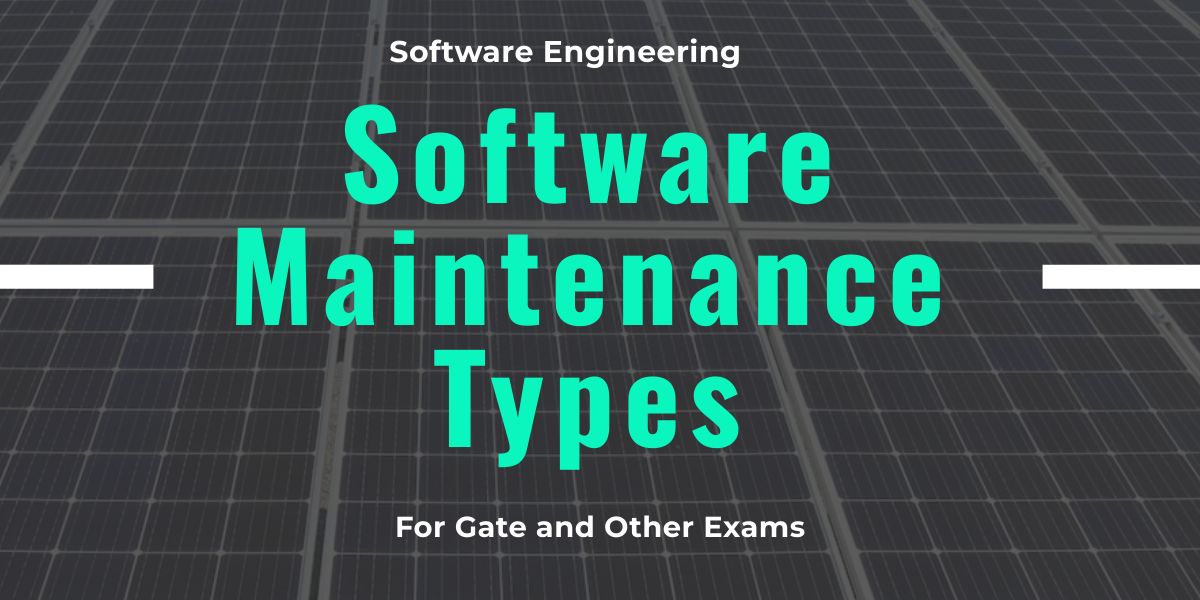
Software Maintenance Types
1️⃣ Corrective Maintenance
Definition:
Corrective maintenance is aimed at fixing defects or bugs in the software that were discovered after the software has been deployed. These issues may include incorrect functionality, errors, crashes, or security vulnerabilities.
Purpose:
- To resolve defects identified during testing or by end-users after the software is released.
- To ensure the system behaves as expected.
Example:
- Fixing a Bug:
- Scenario: After a user submits a form on a website, the page crashes.
- Action: Developers debug the issue, identify a coding error that causes the crash, and implement a fix.
- Outcome: The form submission functionality is restored and works as expected.
- Security Patch:
- Scenario: A vulnerability is discovered in a web application that allows attackers to access user data.
- Action: A corrective patch is applied to fix the security loophole.
- Outcome: The software is secure again, protecting users’ sensitive data.
2️⃣ Adaptive Maintenance
Definition:
Adaptive maintenance involves modifying the software to keep it compatible with new environments, technologies, or business requirements. This includes adapting the software to new operating systems, third-party tools, or hardware.
Purpose:
- To adapt the system to changes in its operating environment, such as upgrades to hardware, software, or external systems.
- To ensure that the software remains relevant and compatible as technologies evolve.
Example:
- OS Compatibility:
- Scenario: The software works perfectly on Windows 10, but Windows 11 is released.
- Action: The application is updated to support Windows 11, ensuring the software works properly on the new operating system.
- Outcome: Users can now run the software on Windows 11 without issues.
- Third-Party API Update:
- Scenario: A payment gateway API version is deprecated, and a new version is released.
- Action: The software’s payment module is updated to use the new API version.
- Outcome: Payment transactions continue to work seamlessly with the new API version.
3️⃣ Perfective Maintenance
Definition:
Perfective maintenance focuses on improving the software by enhancing its functionality, improving performance, or adding new features based on user feedback or business requirements. This type of maintenance is driven by optimization and user satisfaction.
Purpose:
- To improve system performance, add features, or refine existing functionality based on feedback from end-users or stakeholders.
- To increase usability, and extend functionality to meet new business needs.
Example:
- Performance Optimization:
- Scenario: A customer service application takes a long time to load customer data, especially when the database grows large.
- Action: The development team optimizes database queries and refines the data-fetching process to improve speed.
- Outcome: The application loads customer data much faster, improving the user experience.
- Adding a New Feature:
- Scenario: A weather forecasting application only displays current weather, but users request a feature to view weather forecasts for the week.
- Action: The development team adds the weekly forecast feature to the app.
- Outcome: Users can now check the weather forecast for the upcoming days, enhancing the functionality of the app.
4️⃣ Preventive Maintenance
Definition:
Preventive maintenance involves making modifications to improve the software’s longevity and reduce the likelihood of future issues. This includes proactively addressing potential problems and optimizing the software to avoid defects before they occur.
Purpose:
- To anticipate and prevent future failures by proactively improving the system and identifying areas of potential risk.
- To extend the life of the software by improving code quality and maintaining software health.
Example:
- Code Refactoring:
- Scenario: The codebase of a web application has become complex and difficult to maintain.
- Action: The development team performs code refactoring to simplify the code, remove redundancy, and improve maintainability.
- Outcome: The code is now easier to maintain, and future changes or bug fixes are less likely to cause problems.
- Library or Dependency Upgrades:
- Scenario: A software project is using outdated versions of certain libraries, which could cause future compatibility issues.
- Action: The development team upgrades these libraries to the latest versions to ensure compatibility with future technologies.
- Outcome: The software remains compatible with future versions of external tools, reducing the risk of failures.
Comparison of Software Maintenance Types
| Type | Definition | Primary Focus | Examples |
|---|---|---|---|
| Corrective Maintenance | Fixing bugs and defects after release | Bug fixing and defect resolution | Fixing crashes or malfunctioning features. |
| Adaptive Maintenance | Modifying the software to work in new environments | Compatibility with new systems, tools, or hardware | Updating software for new OS versions or third-party tool updates. |
| Perfective Maintenance | Enhancing functionality and performance | Performance improvements, adding new features | Adding new features, improving UI, or optimizing performance. |
| Preventive Maintenance | Preventing future issues | Identifying and addressing areas prone to failure | Refactoring code, upgrading deprecated libraries. |


